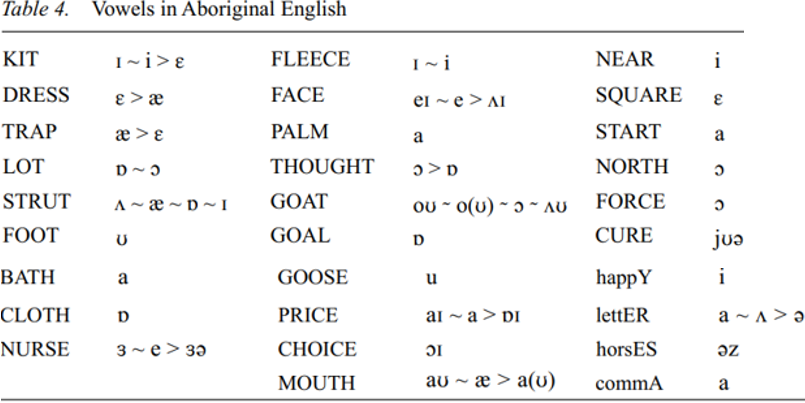


 Grammar
Grammar
 Tenses
Tenses
 Present
Present
 Past
Past
 Future
Future
 Parts Of Speech
Parts Of Speech
 Nouns
Nouns
 Verbs
Verbs
 Adverbs
Adverbs
 Adjectives
Adjectives
 Pronouns
Pronouns
 Pre Position
Pre Position
 Preposition by function
Preposition by function 
 Preposition by construction
Preposition by construction
 Conjunctions
Conjunctions
 Interjections
Interjections
 Grammar Rules
Grammar Rules
 Linguistics
Linguistics
 Semantics
Semantics
 Pragmatics
Pragmatics
 Reading Comprehension
Reading Comprehension|
Read More
Date: 2024-05-03
Date: 2024-03-14
Date: 2024-05-06
|
Speakers in many areas distinguish fewer vowels and diphthongs than in StE. At the more extreme end of the continuum of varieties, Aboriginal English would show little difference from Australian creoles with respect to its repertoire of vowels. Thus, for example, in a description of Aboriginal English as spoken in Queensland, Flint (1968: 12) identifies the dialect as having five vowels, /i/, /e/, /a/, /o/ and /u/, with phonemic length on /i/, /a/, /o/ and /u/. The dialect is, however, much more inherently variable than this would suggest, and some of the variability is suggested in the following table based on Wells’ (1982) word list:

It will be observed with respect to high front vowels that (as in the case of the varieties reported on by Holm 1988−1989), Aboriginal English may sometimes not observe the opposition between /i/ and /ɪ/ or may simply observe long and short forms of /i/. In addition, there may be no discrimination between the mid front vowels /ε/ and /æ/, or between these and the high front vowels.
The mid central vowel /з/ is not consistently present. It may alternate with, or be supplanted by, the mid front vowels /ε/ or /e/, or by the diphthong /εə/ (Alexander 1965: 57). The neutral short vowel /ə/ tends to be replaced by the mid central vowel /Λ/ , as in /jΛsεlf/ ‘yourself’ or by the low central vowel /a/. The StE vowel /Λ/ , for its part, may not always occur in contexts where it would be expected, but may alternate with either front or back vowel alternatives. In Woorabinda, Queensland, the following alternations have been noted: [Λ ~ ɪ ~ æ ~ ɒ] (Alexander 1968).
The low central vowel /a/, which is the most commonly-occurring in Aboriginal languages Readdy (1961: 60), is widely distributed in Aboriginal English and often occurs in contexts where StE would use /ə/.
The mid back vowels /ɒ/ and /ɔ/ are often used interchangeably, thus /dɔg/ ‘dog’, and, under influence from creole, they may also alternate with /o/ (Alexander 1968).
The high back vowel /u/, which is widespread in Aboriginal languages and creoles, is also widespread in Aboriginal English.
There is a strong tendency in Aboriginal English (shared to some extent by Australian English, as well as by creoles) for diphthongs to be monophthongized (Readdy 1961: 64; Alexander 1968; Eagleson, Kaldor and Malcolm 1982). Only /ɔɪ/ and /ʊə/ seem unaffected by this. With respect to the other diphthongs, /eɪ/ may become /e/ or /ε:/, /oʊ/ may become /o/, /aɪ/ may become /a:/; /aʊ/ may become /a(U)/ or, under the influence of Australian English, /æ/, /ɪə/ may become /i/ and /εə/ , /ε:/.
Although Australian English is well known for its diaphonic variation which distinguishes cultivated from broad and general speech, the influence on Aboriginal English of the broad variants is not as pervasive as might be expected, and some of the Aboriginal English vowels have been compared to American rather than broad Australian variants (Sharpe 1976: 15−16). Broad Australian variants are, however, not entirely absent from Aboriginal English.
|
|
|
|
لخفض ضغط الدم.. دراسة تحدد "تمارين مهمة"
|
|
|
|
|
|
|
طال انتظارها.. ميزة جديدة من "واتساب" تعزز الخصوصية
|
|
|
|
|
|
|
مشاتل الكفيل تزيّن مجمّع أبي الفضل العبّاس (عليه السلام) بالورد استعدادًا لحفل التخرج المركزي
|
|
|